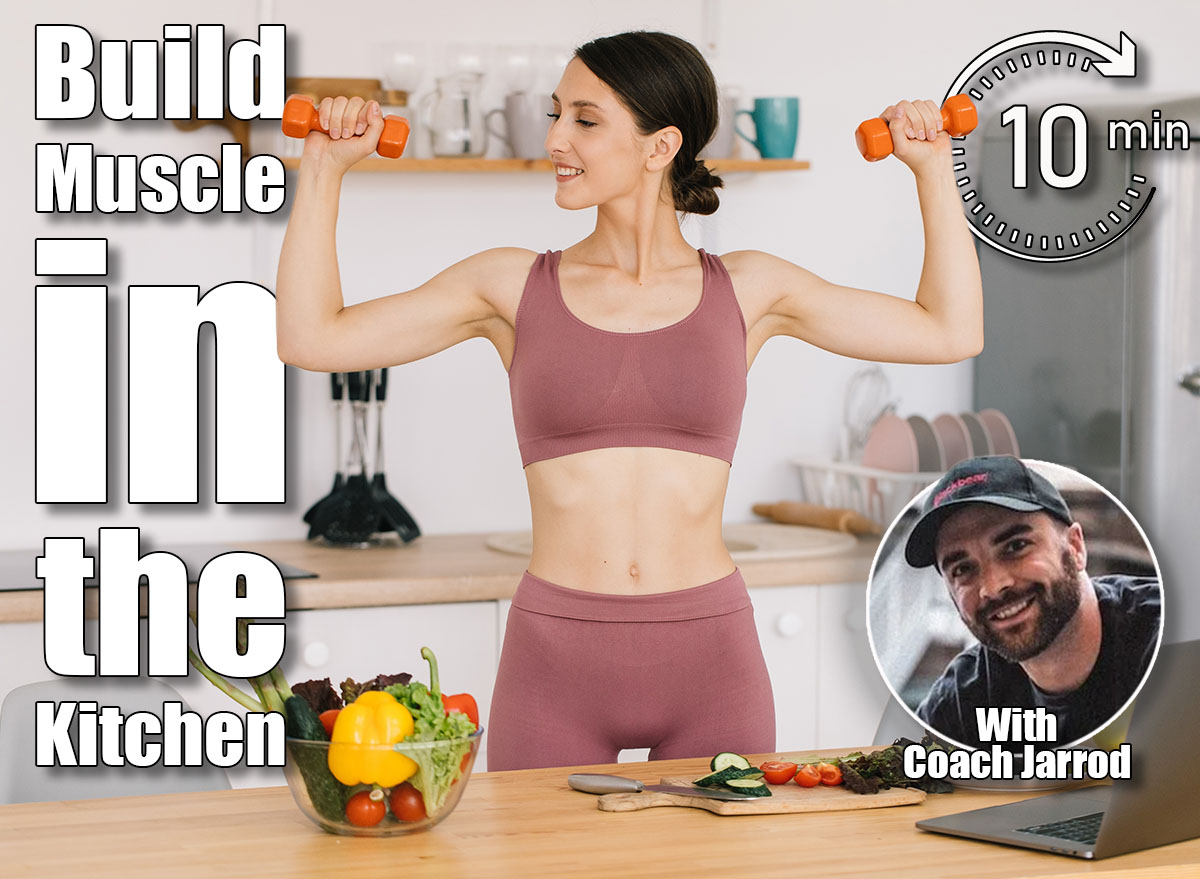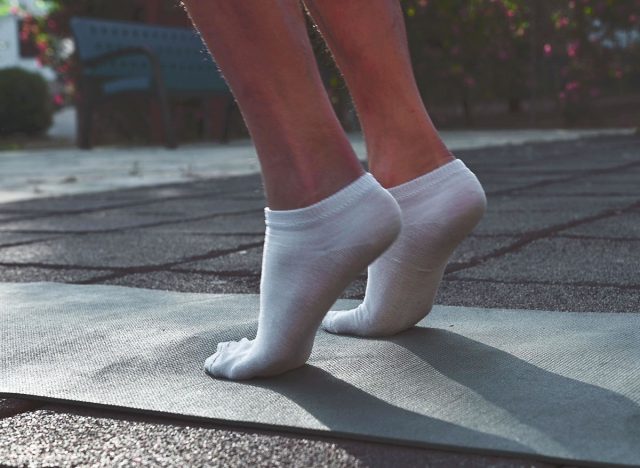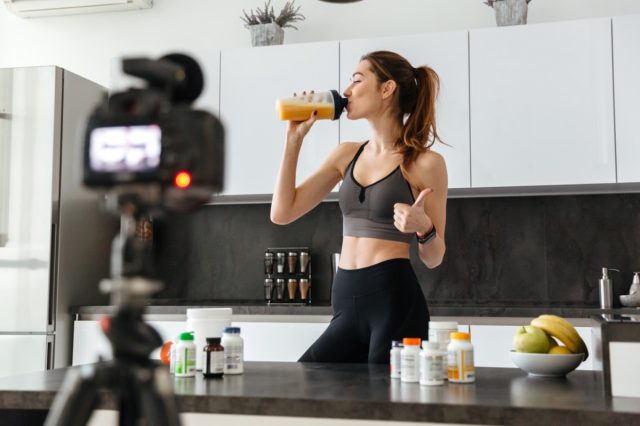6 Kitchen Counter Moves That Build More Muscle Than CrossFit After 50

Your kitchen counter is more than a spot for chopping vegetables or brewing your morning coffee. With the right approach, it becomes a surprisingly effective training station that’s always within arm’s reach.
After 50, building and keeping muscle isn’t about chasing the latest fitness trend. It’s about finding simple ways to challenge your body that also protect your joints. The counter gives you the stability you need while still letting you push hard enough to see results. Plus, there’s something satisfying about turning everyday spaces into part of your workout routine.
You don’t need a gym membership or complicated equipment to feel stronger and move better. These counter-based exercises train your arms, legs, and core in ways that fit neatly into your day. If you can make coffee, you can sneak in a set. And if anyone asks why you’re working out in the kitchen, you can just tell them you’re “cooking up some muscle.”
Coming up, I’ll walk you through six simple moves you can do against your counter that build real strength and confidence after 50. Think of it as the easiest home upgrade you’ll ever make—no contractor required.
6 Kitchen Counter Moves to Build Muscle After 50
Counter Push-Ups
Push-ups are a cornerstone of upper-body strength, and the counter version makes them accessible while still highly effective. Elevating your hands reduces stress on your shoulders and wrists, which is especially important after 50 when joints may not bounce back as quickly. The incline angle also allows you to perform more controlled reps with better form, which means greater muscle activation in your chest, shoulders, and arms. Over time, this leads to increased pushing power for daily tasks such as lifting groceries, pushing a heavy door, or carrying luggage. And because your core stays engaged, every rep doubles as a stability drill for your midsection.
Muscles Trained: Chest, triceps, shoulders, core.
How to Do It:
- Place both hands shoulder-width apart on the counter.
- Step your feet back until your body forms a straight line.
- Lower your chest toward the counter, elbows tracking back at about 45 degrees.
- Press through your palms to return to the start position.
- Keep your core tight and body aligned throughout.
Recommended Sets and Reps: 3 sets of 12 to 15 reps. Rest 60 seconds.
Best Variations: Narrow-grip push-ups, single-leg push-ups, tempo push-ups.
Form Tip: Keep your body in a straight line, like a plank, as you move.
Counter Squats
Squats are essential for keeping your legs strong, and the counter gives you just the right amount of assistance to build confidence and depth. After 50, leg strength directly translates to independence. Everything from climbing stairs to getting up from a chair depends on it. By lightly holding the counter, you can sit deeper into the squat without fear of losing balance, which activates more muscle fibers in your glutes and quads. Stronger legs protect your knees and hips, reduce the risk of falls, and give you the endurance to walk longer, hike, or simply keep up with kids and grandkids without fatigue.
Muscles Trained: Quads, glutes, hamstrings, calves.
How to Do It:
- Stand facing the counter with feet shoulder-width apart.
- Lightly hold the edge for support.
- Sit back into your hips and bend your knees until your thighs are nearly parallel.
- Drive through your heels to stand tall.
- Squeeze your glutes at the top.
Recommended Sets and Reps: 3 sets of 12 to 20 reps. Rest 90 seconds.
Best Variations: Pulse squats, single-leg counter squats, sit-to-stand squats with support.
Form Tip: Avoid letting your knees cave inward. Press them slightly outward.
Counter-Assisted Split Squats
Single-leg strength is a game-changer for balance, coordination, and injury prevention. With age, strength imbalances between legs become more noticeable and can lead to falls or joint strain. Split squats target each leg independently, forcing your weaker side to catch up while engaging stabilizing muscles around your hips and knees. The counter provides security, allowing you to focus on building strength instead of worrying about tipping over. The payoff is smoother movement, better posture, and stronger legs for activities like walking on uneven ground, climbing stairs, or even gardening without discomfort.
Muscles Trained: Quads, glutes, hamstrings, calves, core.
How to Do It:
- Stand a step away from the counter, lightly holding it with one hand.
- Step one foot back into a staggered stance.
- Lower your back knee toward the floor, keeping your front knee over your toes.
- Press through the front heel to return to standing.
- Complete reps on one side, then switch legs.
Recommended Sets and Reps: 3 sets of 10 to 12 reps per leg. Rest 60 to 90 seconds.
Best Variations: Elevated rear foot split squat, pulse split squat, isometric hold.
Form Tip: Keep most of your weight in your front leg rather than leaning heavily on the counter.
Counter Plank Holds
Core strength aids in protecting your spine and supporting every movement you make. Planks at the counter give you a safer entry point into core training, especially if getting on and off the floor feels uncomfortable. This variation still challenges your abs, obliques, and deep stabilizers, but with less strain on your lower back. A stronger core helps you maintain better posture, reduces stiffness during long periods of sitting, and makes lifting or twisting tasks easier and safer. It’s the kind of exercise that pays off every time you bend, reach, or carry something.
Muscles Trained: Core, shoulders, chest, lower back.
How to Do It:
- Place forearms or palms flat on the counter.
- Step your feet back until your body forms a straight line.
- Engage your abs and glutes, avoiding sagging hips.
- Hold for time while breathing steadily.
Recommended Sets and Reps: 3 sets of 20 to 45 seconds. Rest 60 seconds.
Best Variations: Side planks at the counter, shoulder taps, slow mountain climbers.
Form Tip: Pull your belly button toward your spine to lock in your core.
Counter Calf Raises

Calves are often overlooked, but they’re critical for mobility, stability, and balance. They act as shock absorbers every time you walk, run, or take the stairs. After 50, weak calves can make your stride shorter and less powerful, which not only slows you down but also raises fall risk. Calf raises at the counter allow you to move through a full range of motion with extra balance support, ensuring you hit those small but mighty muscles completely. Building stronger calves means longer walks, better ankle stability, and the confidence to move quickly without hesitation.
Muscles Trained: Calves, ankles, and foot stabilizers.
How to Do It:
- Stand facing the counter with hands resting lightly on it.
- Rise onto the balls of your feet, lifting your heels as high as possible.
- Pause briefly at the top.
- Lower your heels under control.
Recommended Sets and Reps: 3 sets of 15 to 20 reps. Rest 60 seconds.
Best Variations: Single-leg calf raises, pause holds at the top, tempo calf raises.
Form Tip: Keep your knees slightly soft to avoid locking them out.
Counter Tricep Dips
Strong triceps don’t just make your arms look better in a short-sleeve shirt; they also play a major role in pushing strength. These muscles power you through everything from pushing yourself up off the couch to loading boxes or even catching yourself if you stumble. After 50, the triceps are one of the first muscles to lose tone, so training them consistently makes a visible and functional difference. Using the counter as support creates a safe and controlled way to strengthen your arms without straining your shoulders. Over time, you’ll notice firmer arms and more ease with daily pressing tasks.
Muscles Trained: Triceps, shoulders, chest.
How to Do It:
- Stand with your back to the counter.
- Place both hands on the edge behind you.
- Step your feet forward and bend your elbows to lower your body.
- Press through your palms to return to the top.
- Control each rep to maximize muscle activation.
Recommended Sets and Reps: 3 sets of 10 to 15 reps. Rest 60 to 90 seconds.
Best Variations: Bent-knee dips, single-leg dips, tempo dips.
Form Tip: Keep your elbows pointing straight back rather than flaring out.
The Best Strength Tips for Over-50 Training in the Kitchen

Building muscle after 50 isn’t about intensity alone. You need a solid dose of consistency, smart progression, and recovery. Here are the top strategies to get the most out of these kitchen counter workouts:
- Pair moves with daily habits: Attach each exercise to something you already do, like waiting for coffee to brew. This ensures you stay consistent without needing extra time.
- Track small wins: Write down your reps and sets. Adding one more rep or holding a plank a few seconds longer adds up to steady strength gains.
- Progress with purpose: Start with the basic version of each exercise, then move to single-leg, tempo, or pause variations once the basics feel comfortable.
- Recover well: Give your muscles time to rebuild stronger. Take at least one day of lighter movement, prioritize quality sleep, and stay hydrated.
- Fuel your training: Protein intake is critical for muscle maintenance after 50. Aim for protein at each meal to support recovery and growth.
- Mix with walking or light cardio: These counter drills cover strength, but pairing them with daily walking keeps your endurance and heart health sharp.
Looking for easy ways to lose fat? Here’s How Long Your Walking Workout Should Be To Shrink Belly Fat.